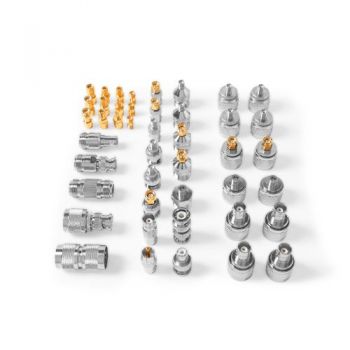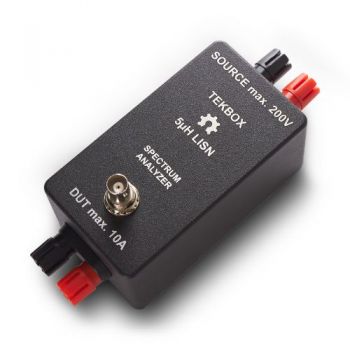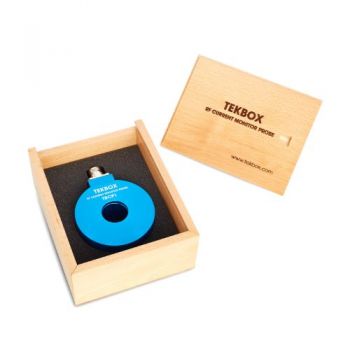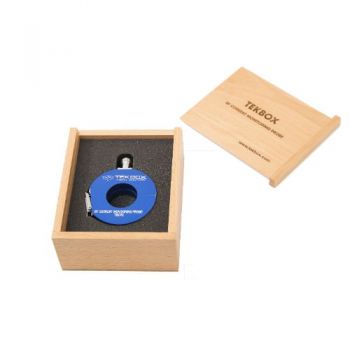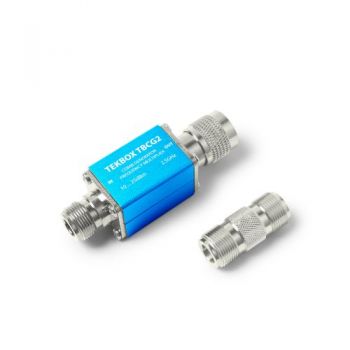Products
The H20, H10, H5, and E5 are magnetic field (H) and electric field (E) probes for radiated emissions EMC pre-compliance measurements. The probes are used in the near field of sources of electromagnetic radiation. They serve to locate and identify potential sources of interference within the building blocks of electronic assemblies. The probes act similar to wide bandwidth antennas, picking up radiated emissions from components, PCB traces, housing openings or gaps and from any other parts that could be emitting RF. The probes are usually connected to a spectrum analyzer. Scanning the probe over the surface of a PCB assembly or housing quickly identifies locations which emit electromagnetic radiation. By changing to a probe with a smaller size, the origination of the emissions can be further narrowed down. With TBWA2 WIDEBAND AMPLIFIER/40DB
The H20, H10, H5, and E5 are magnetic field (H) and electric field (E) probes for radiated emissions EMC pre-compliance measurements. The probes are used in the near field of sources of electromagnetic radiation. They serve to locate and identify potential sources of interference within the building blocks of electronic assemblies. The probes act similar to wide bandwidth antennas, picking up radiated emissions from components, PCB traces, housing openings or gaps and from any other parts that could be emitting RF. The probes are usually connected to a spectrum analyzer. Scanning the probe over the surface of a PCB assembly or housing quickly identifies locations which emit electromagnetic radiation. By changing to a probe with a smaller size, the origination of the emissions can be further narrowed down. With TBWA2 WIDEBAND AMPLIFIER/20DB
The TBCAS1 coaxial adapter set contains 44 pieces of the most common 50 Ohm coaxial adapters in a beechwood box
The H20, H10, H5, and E5 are magnetic field (H) and electric field (E) probes for radiated emissions EMC pre-compliance measurements. The probes are used in the near field of sources of electromagnetic radiation. They serve to locate and identify potential sources of interference within the building blocks of electronic assemblies. The probes act similar to wide bandwidth antennas, picking up radiated emissions from components, PCB traces, housing openings or gaps, and from any other parts that could be emitting RF. The probes are usually connected to a spectrum analyzer. Scanning the probe over the surface of a PCB assembly or housing quickly identifies locations that emit electromagnetic radiation. By changing to a probe with a smaller size, the origination of the emissions can be further narrowed down.
The TBMR-110M EMI Analyzer is designed to carry out conducted emission measurements. Its affordability and versatility make it a perfect tool for engineers doing pre-compliance measurements during the development process.
- True DC – 110 MHz measurement range
- CISPR-16, ANSI and MIL-STD compliant detectors
- Peak, Quasi-Peak, Average, CISPR Average, RMS and CISPR RMS dectectors working in parallel
- Zero Span operation with time domain triggering
- Linear, log amplitude and frequency display
The TBLC08 is a Line Impedance Stabilization Network for the measurement of line-conducted interference within the range of 9kHz to 30MHz, according to the CISPR16 standard. The device is designed for testing single phase, AC-powered equipment with supply voltages up to maximum 240V.
The TBOH01 5µH LISN is a device required to setup conducted noise measurements of DC-powered devices. It is designed to be used for EMC pre-testing in the frequency range of 150kHz to 110 MHz.
The TBLM1 LISN Mate is a companion device for LISNs, which splits the conducted noise signal into its common mode and differential mode components. The LISN Mate is connected to the output of a LISN inserted into the positive supply line and to a second LISN inserted into the negative supply line.
The TBCP1-200, TBCP1-250, and TBCP1-500 is fixed aperture RF current monitoring probe, expanding the Tekbox product range of affordable EMC pre-compliance test equipment. The probe has a 3dB bandwidth of approximately 200 MHz and is characterized and usable over the frequency range from 10kHz to 500 MHz. The aperture of the RF current monitoring probe is 25 mm. Its transfer impedance is > 14 dB Ohm in the range from 40 kHz to 200 (500) MHz.
The TBCP2-250, -500, -750 -30K400 are snap-on RF current monitoring probes with very flat response of a 3dB bandwidth.
The TBCG1 is a radiating comb generator with an internal antenna and a base frequency of 100MHz. It radiates a comb spectrum characterized up to 6GHz. The comb generator is built and characterized to serve as a rough reference for testing radiated noise measurement set ups in anechoic chambers, TEM/GTEM cells, shielded chambers, etc.
The TBCG2 is a passive, step recovery diode based comb generator/frequency multiplier. It is optimized for moderate drive power and spectrum flatness in the frequency range 1 MHz to 2.5GHz. The recommended drive power is +10 dBm to +20 dBm The frequency range for the drive signal is 1 MHz to 350MHz


